How should the African-American story of the Civil War be told?
While slavery was the major issue separating the North and South, it was not slavery itself that sparked the conflict. The South wanted to secede from the Union, and the North refused. While President Abraham Lincoln personally opposed slavery, he recognized that it was legal under the U.S. Constitution at the time. He also recognized that few in the North were ready to go to war to free the slaves. For Lincoln and the northern majority, preservation of the Union was the foremost goal.
Freed Slaves during the Civil War
The "Negro question," as it was called, became an important issue early in the conflict. Most slaves were in fact "liberated" when the Union Army eliminated the local southern forces that kept them in slavery. They simply left their plantations to seek their freedom under the protection of northern military units. Union commanders had to decide how to deal with them. Early in the fighting in border states, slaves were sometimes returned to their masters in the hope of encouraging support for the Union.
However, as more and more slaves walked to freedom, the army made provisions to use them as a resource. The army hired many to work in non-military roles — cooks, wagon drivers, blacksmiths, laundresses — but until later in the conflict, racial prejudice prevented arming former slaves and allowing to fight. As the war progressed, however, African Americans could sign up for combat units. By the end of the Civil War, some 179,000 African-American men served in the Union army, equal to 10 percent of the entire force. Of these, 40,000 African-American soldiers died, including 30,000 of infection or disease.
The Confederate armies did not treat captured African-American soldiers under the normal "Prisoner of War" rules. At Fort Pillow, Tennessee, there are claims that 300 African-American Union soldiers were massacred after they surrendered when they were badly outmatched by southern forces. This led President Lincoln to warn the South that the North would not participate in prisoner exchanges that were common wartime practice unless all Union soldiers of whatever race were treated by POW rules.
Emancipation Proclamation
Lincoln issued his famous Emancipation Proclamation in 1863 freeing all slaves in states rebelling against the United States. It had its greatest effect when Union armies defeated rebel forces in the so-called Confederate states. He justified the program under his wartime powers declaring that slaves contributed substantially to the support of the Confederacy. Eliminating slave labor, the Proclamation reasoned, would severely undercut the southern rebellion.
At the close of the war, it was obvious that slavery was over. Most African Americans had walked away from their bondage, and there was no sentiment in the North to reward southern slaveholders with the return of their slaves. The new debate was about status of African Americans in American society. The radical wing of the Republican Party pushed the federal government to keep troops in the South to insure African-American rights, including suffrage. Congress proposed three constitutional amendments that would promote African-American equality. The 13th Amendment forbade slavery. The 14th Amendment required all states to abide by due process for all citizens, and the 15th Amendment denied states the right to impose voting restrictions based on race or previous condition or servitude (slavery). The government and private organizations sponsored schools to teach African-American children and trade schools for adults.
However, in 1876, a stand-off in the presidential election created a constitutional crisis. As a compromise, Rutherford B. Hayes, the Republican, became president but federal troops were withdrawn from Confederate states. This opened the way for white majorities in these states to reimpose laws that discriminated against African Americans. In 1896, the Supreme Court upheld a law that allowed states to create "separate but equal" schools and other institutions based on race, and segregation tightened its grip on the American South.
Supporting Questions
How did President Abraham Lincoln and Congress' approach to handling slavery evolve throughout the Civil War?
- "The (Fort) Monroe Doctrine," 1861 (Political Cartoon)
- President Abraham Lincoln's First Inaugural Address, March 9, 1861 (Document)
- First Confiscation Act: "Chap. LX - An act to confiscate Property used for Insurrectionary Purposes," August 6, 1861 (Document)
- "I'm sorry to have to drop you, Sambo, but this concern won't carry us both!" October 12, 1861 (Political Cartoon)
- Proclamation Revoking General David Hunter’s General Order No. 11 on Military Emancipation of Slaves, May 19, 1862 (Document)
- Second Confiscation Act: "Chap. CXCV - An Act to Suppress Insurrection, to Punish Treason and Rebellion...," July 17, 1862 (Document)
- Militia Act, July 17, 1862 (Document)
- President Abraham Lincoln's Letter to Horace Greeley, August 29, 1862 (Document)
- First Edition of President Abraham Lincoln’s Preliminary Emancipation Proclamation, September 22, 1862 (Document)
- President Abraham Lincoln's Letter to Albert G. Hodges, April 30, 1864 (Document)
- Print of Emancipation Proclamation by President Abraham Lincoln, 1865 (Document)
- Joint Resolution Submitting the 13th Amendment to the States, February 1, 1865 (Document)
What contributions did slaves and free African Americans make to the Union war effort?
- Contributions Behind Rebel Lines
- Contributions of Physical Labor
- Contributions of Service to Union Soldiers
- Contributions in Combat
After a Union victory and the close of the war, what possibilities did the future hold for all African Americans?
- Acceptance as an Equal, Fellow Man
- "Men of Color to Arms! Now or Never!" Broadside, 1863 (Document)
- "One Cause, One Country - 45th Regt. U.S. Colored Troops," between 1863 and 1865 (Image)
- "Emancipation," 1865 (Image)
- "Give Me Your Hand, Comrade," April 22, 1865 (Political Cartoon)
- "The True Defenders of the Constitution," November 11, 1865 (Image)
- Political Equality
- Economic Freedom
| African Americans and the Civil War Source Set Teaching Guide |
| Printable Image and Document Guide |
“Emancipation,” 1865
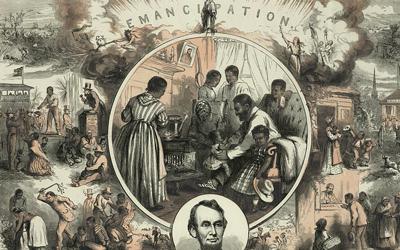
Description
In his 1865 image titled "Emancipation," Thomas Nast celebrates the emancipation of southern slaves with the end of the Civil War by contrasting a life of suffering and pain before the conflict with a life of optimism and freedom afterwards. The central scene shows the…
"Men of Color to Arms! Now or Never!" Broadside, 1863

Description
In this 1863 recruitment broadside written by Frederick Douglass and published in Philadelphia, African Americans were urged to volunteer for the Union army to secure liberty and prove their worth to society as both men and citizens. Douglass warned through the broadside…
"Give Me Your Hand, Comrade," April 22, 1865
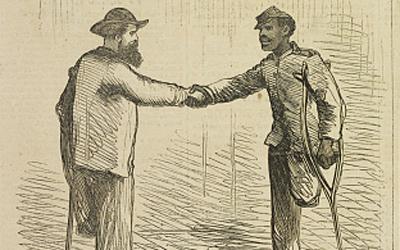
Description
Appearing April 22, 1865, only two weeks after Robert E. Lee's surrender at Appomattox, this illustration shows two Union veterans, one white and one African American, shaking hands. Both soldiers have had a leg amputated. Below the illustration, the caption reads, "A Man…
"The Darkies Rally" Song, 1863

Description
Written and composed in 1863 by W.W. Partridge, "The Darkies Rally" was a recruitment song that called for African Americans to volunteer to join the Union army. Motivations for doing so included the promises of their own home, a safe and secure family, employment for pay…
Narrative of Former Slave Felix Haywood, 1936
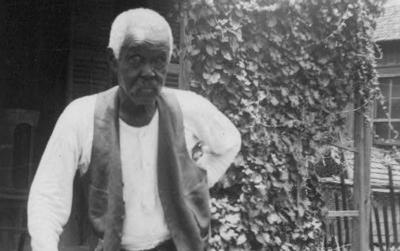
Description
Fred Dibble and Rheda Beehler traveled to various parts of Texas to interview former slaves as part of the Federal Writers' Project of the Works Progress Administration. This narrative captures the story of Felix Haywood of San Antonio, Texas, who recalls his time as a…
"The Negro as a Soldier in the War of the Rebellion" Pamphlet, 1897
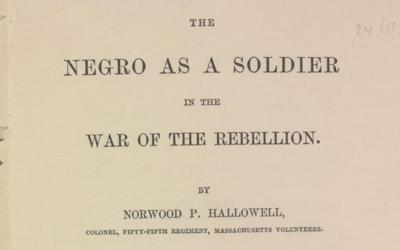
Download Resource Download Resource
Description
On January 5, 1862, Colonel Norwood P. Hallowell delivered his "The Negro as a Soldier in the War of the Rebellion" speech to the Military Historical Society of Massachusetts. In that speech, he described several Civil War battles in which African-American soldiers…
"The (Fort) Monroe Doctrine," 1861
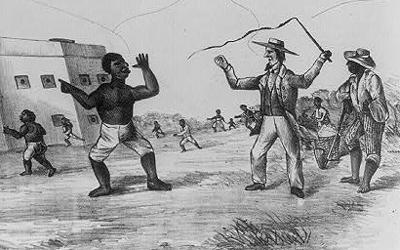
Description
In this political cartoon, a slave stands before Fort Monroe taunting his plantation master. The planter (right) waves his whip and cries, "Come back you black rascal." The slave replies, "Can't come back nohow massa Dis chile's contraban." In the background, other…
President Abraham Lincoln's First Inaugural Address, March 9, 1861

Description
On March 9, 1861, The Burlington Weekly Hawk-eye printed in full President Abraham Lincoln’s first inaugural address in which the new president stressed the Union between the North and South and his constitutional duty to maintain and defend it. Although the…
First Confiscation Act: "Chap. LX - An act to confiscate Property used for Insurrectionary Purposes," August 6, 1861
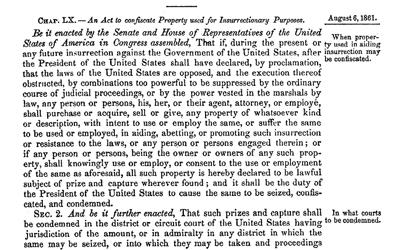
Description
After the breakout of the Civil War, on July 4, 1861, President Abraham Lincoln convened a special session of Congress. One issue that needed to be addressed was legislation addressing how to deal with slaves being used to aid the war effort of the Confederacy, including…
"I'm sorry to have to drop you, Sambo, but this concern won't carry us both!" October 12, 1861
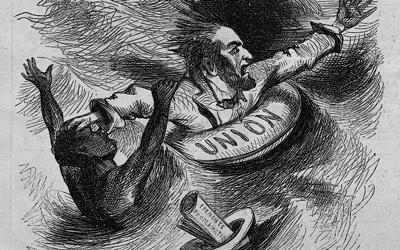
Description
On August 30, 1861, General John C. Fremont issued a proclamation for the state of Missouri in which he declared martial law and announced the emancipation of slaves owned by Confederate sympathizers in the state. Fremont acted without Lincoln's permission and was asked by…
Proclamation Revoking General David Hunter’s General Order No. 11 on Military Emancipation of Slaves, May 19, 1862
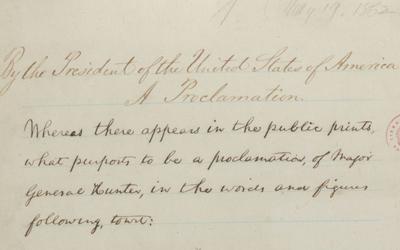
Description
On May 9, 1862, Major General David Hunter issued a proclamation that placed Florida, Georgia and South Carolina under martial law and emancipated all slaves in these states. Ten days later, President Abraham Lincoln announced this proclamation, which publicly voided Hunter…
Second Confiscation Act: "Chap. CXCV - An Act to Suppress Insurrection, to Punish Treason and Rebellion...," July 17, 1862
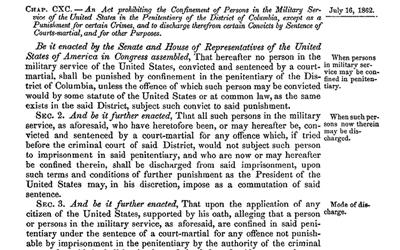
Description
Like the First Confiscation Act of August 6, 1861, the Second Confiscation Act of July 17, 1862, authorized the seizure of property owned by disloyal citizens. However, this law expressly called for emancipation of slaves in three cases…
Militia Act, July 17, 1862
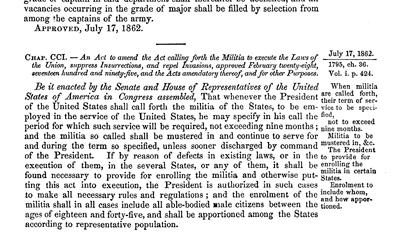
Description
Passed alongside the Second Confiscation Act on July 17, 1862, the Militia Act of 1862 amended the Militia Act of 1795, making it legal for African-American men to enlist in the United States army "for the purpose of constructing intrenchments, or performing camp service or…
President Abraham Lincoln's Letter to Horace Greeley, August 29, 1862
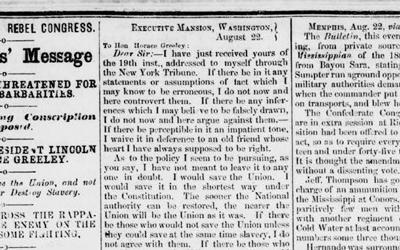
Description
On August 20, 1862, the influential editor of the New York Tribune, Horace Greeley, published an open letter to President Abraham Lincoln under the heading "The Prayer of Twenty Millions." In it, he accused Lincoln of not faithfully executing recent laws passed by…
First Edition of President Abraham Lincoln’s Preliminary Emancipation Proclamation, September 22, 1862
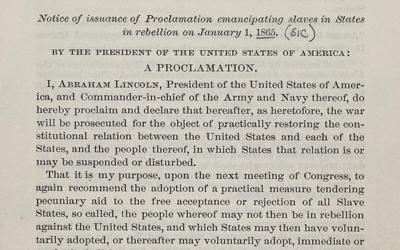
Description
Five days after signing the Second Confiscation Act, on July 22, 1862, President Abraham Lincoln notified his cabinet members his plan for issuing a preliminary draft of the Emancipation Proclamation based on the authority Congress had…
President Abraham Lincoln's Letter to Albert G. Hodges, April 30, 1864
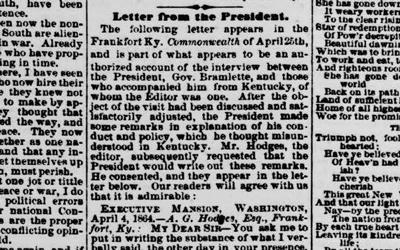
Description
This letter is a summary of a conversation which President Abraham Lincoln had with three Kentuckians: Governor Thomas E. Bramlette, former United States Senator Archibald Dixon and Albert G. Hodges, editor of the Frankfort Commonwealth. The letter provided a…
Print of Emancipation Proclamation by President Abraham Lincoln, 1865
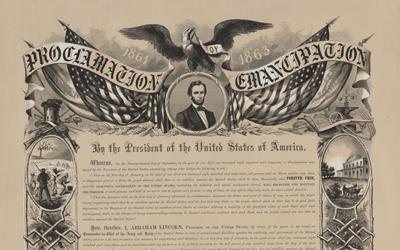
Description
One hundred days after announcing the preliminary Emancipation Proclamation, on January 1, 1863, the final Emancipation Proclamation took effect. The final proclamation differed significantly from the previous one. It designated the areas…
Joint Resolution Submitting the 13th Amendment to the States, February 1, 1865
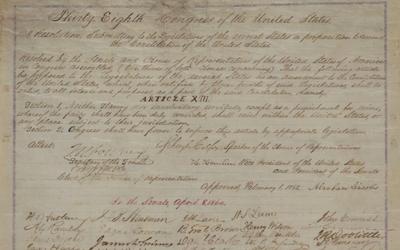
Description
On April 8, 1864, the United States Senate passed a resolution proposing an amendment that would abolish slavery throughout America. The House of Representatives initially failed to pass its own resolution and did not do so until January 31, 1865, after much lobbying from…
"Negroes Leaving the Plough," March 26, 1864

Description
Published in the March 26, 1864, edition of Harper’s Weekly as part of "Scenes Connected with General Custer's Movement Across the Rapidian," Alfred R. Waud's drawing depicts three slaves on horseback leaving the field to join Union troops marching down a nearby…
Portrait of Harriet Tubman, between ca. 1871 and 1876
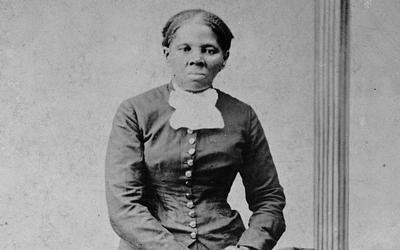
Description
In this portrait-style photograph, Harriet Tubman is found standing in a dress with her hands resting on the back of an upholstered chair. The photograph was taken sometime between 1871 and 1876 by Harvey B. Lindsley. Best known for her work with the Underground Railroad,…
Men Standing On Railroad Track in Northern Virginia, ca. 1862
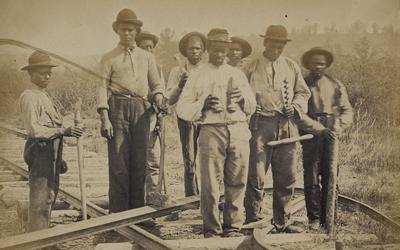
Description
This photograph shows a group of eight African Americans constructing a railroad in northern Virginia for the United States Military Railway Department. The photo was taken by Andrew J. Russell in either 1862 or 1863. Most of the men can be seen holding tools required…
African-American Teamsters in Bermuda Hundred, Virginia, 1864
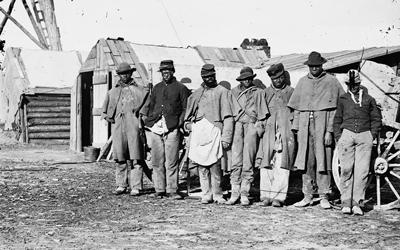
Description
This is one of the Civil War photographs compiled by Hirst D. Milhollen and Donald H. Mugridge. This 1864 image depicts seven "contraband" teamsters dressed in old Union uniforms standing near a wagon and shack.
African Americans Collecting Bones of Soldiers Killed in Cold Harbor, Virginia, April 1865

Description
This photograph, published by John Reekie in April 1865, portrays five African Americans collecting bones of soldiers killed in battle during Ulysses S. Grant's 1864 Virginia Overland Campaign. In the foreground, an African American squats near a stretcher filled with skulls…
Group of Soldiers in Front of Tent in Camp Cameron, between 1861 and 1865
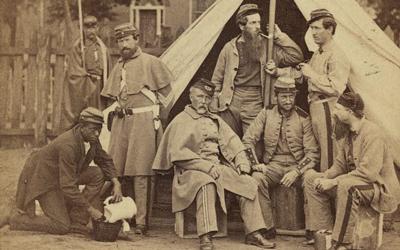
Download Resource Download Resource
Description
Between 1861 and 1865, George N. Barnard and C. O. Bostwick photographed this group of white soldiers, possibly the 8th Company, 7th New York Infantry, at Washington D.C.'s Camp Cameron. Included in the photograph are seven men: three seated and identified as Sergeant Samuel…
"Polishing the General's Britches," between 1861 and 1865
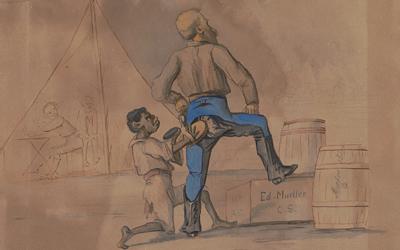
Description
While fighting for the 32nd Indiana during the Civil War, Captain Adolph Metzner documented his experiences through a series of drawings. In this one, an unnamed general stands with one leg raised on a box, one hand on his hip and the other on his knee as an African American…
Officers from the 4th Colored Infantry at Fort Slocum, April 1865
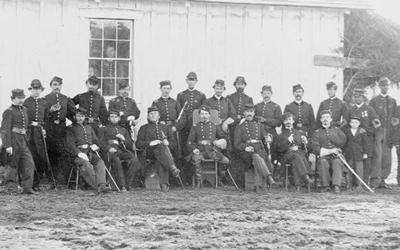
Description
This photograph, taken in April 1865, pictures officers of the 4th United States Colored Infantry at Fort Slocum near New York City. There are two rows of men total with seven men seated in the front and 16 standing in the back. Two African-American NCOs stand on the…
Storming Fort Wagner, July 5, 1890
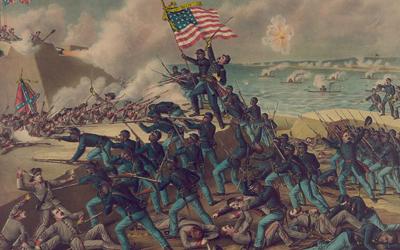
Description
Published July 5, 1890, this colored lithographic print shows the 54th Massachusetts Volunteer Infantry Regiment, led by Colonel Robert Gould Shaw, storming the walls of Fort Wagner on Morris Island, South Carolina, and engaging Confederate soldiers in brutal hand-to-hand…
"One Cause, One Country - 45th Regt. U.S. Colored Troops," between 1863 and 1865
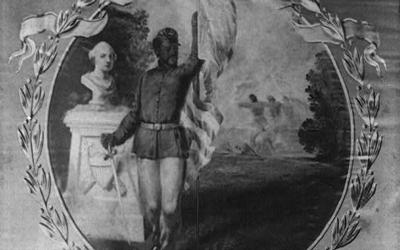
Description
This is an image of the United States Colored Troops, 45th Regiment's flag. On it is an African-American soldier with an American flag in hand standing beside a bust statue of George Washington. More African-American soldiers fight in the background behind him.
"The True Defenders of the Constitution," November 11, 1865
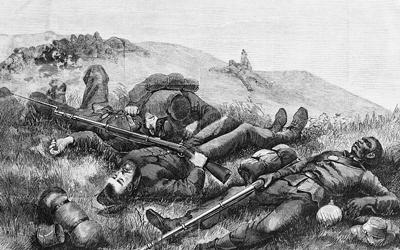
Description
This print portrays the dead bodies of two African-American men and two white men, all Union soldiers, on a battlefield. The print was drawn by James Walker and appeared in the November 11, 1865, edition of Harper’s Weekly.
"24th Regt. U.S. Colored Troops. Let Soldiers in War, Be Citizens in Peace," ca. 1865

Description
This is a photograph of the United States Colored Troops, 24th Regiment’s flag. On it is an African-American soldier standing atop a hill in the middle of a battlefield with his arms stretched towards the sky. Just above his hands are the words "Fiat Justitia," a Latin…
"Pardon. Franchise Columbia," August 5, 1865
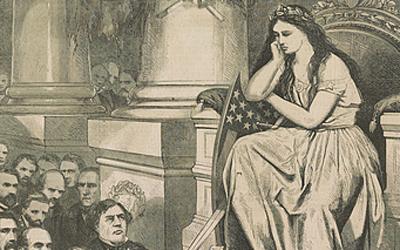
Description
This August 5, 1865, image by Thomas Nast contrasted Confederate politicians and generals begging and pleading for pardons (among them Confederate Vice President Alexander Stephens, Congressman Robert Toombs, Admiral Raphael Semmes, Generals Robert E. Lee, Richard Ewell and…
Additional Resources
- African-American Soldiers in the U.S. Military During the Civil War
This National Archives resource is brief, yet informative and summarizes the obstacles, challenges and successes of African Americans serving in the Civil War. - The Civil War Trust’s Video Collection
The Civil War Trust has created over 300 brief, but informative videos featuring historians discussing a variety of Civil War topics. These resources provide background knowledge and historical context to the Civil War. The following seven resources, in particular, directly relate to the source set: "African-Americans and the Early War Effort," "Contraband: African-Americans," "Black Soldiers in 4 Minutes," "The Road to Emancipation," "Drafting the Proclamation," "The Emancipation Proclamation in 4 Minutes" and "Reactions to the Emancipation Proclamation." - Harper’s Weekly Reports on Black America, 1857-1874 - Civil War Timeline
The Civil War timeline spans from the election of 1860 to the ratification of the 13th Amendment, all the while directing its focus toward decisions, legislation and proclamations made by the federal government related to slaves and free African Americans. - An Evolving Nation
This feature, written for the Civil War Trust by Hari Jones of the African-American Civil War Museum, traces the road toward full emancipation from prior to the Civil War up until the issuing of the Emancipation Proclamation. - Abraham Lincoln and Emancipation
This essay can be found within the Library of Congress' Abraham Lincoln Papers Collection. It sheds light on Lincoln's own actions and decisions in relation to emancipation. A useful timeline can also be found on the left side of the page.
Iowa Core Social Studies Standards (9th-12th Grade)
Listed below are the Iowa Core Social Studies content anchor standards that are best reflected in this source set. The content standards applied to this set are elementary-age level and encompass the key disciplines that make up social studies for students 9th through 12th grade.
| No. | Standard Description |
| SS-US.9-12.13. | Analyze how diverse ideologies impacted political and social institutions during eras such as Reconstruction, the Progressive Era, and the Civil Rights movement. |
| SS-US.9-12.15. | Assess the impact of individuals and reform movements on changes to civil rights and liberties. |
| SS-US.9-12.21. |
Analyze change, continuity and context across eras and places of study from Civil War to modern America. |
| SS-US.9-12.24. | Critique primary and secondary sources of information with attention to the source of the document, its context, accuracy, and usefulness such as the Reconstruction amendments, Emancipation Proclamation, Treaty of Fort Laramie, Chinese Exclusion Act, Roosevelt’s Corollary to the Monroe Doctrine, Wilson’s Fourteen Points, New Deal program acts, Roosevelt’s declaration of war, Executive Order 9066, the Truman Doctrine, Eisenhower’s farewell speech, Gulf of Tonkin Resolution, Test Ban Treaty of 1963, Brown v. Board of Education decision, Letter from a Birmingham Jail, and the Voting Rights Act of 1965. |
| SS-US.9-12.25. | Analyze how regional, racial, ethnic and gender perspectives influenced American history and culture. |